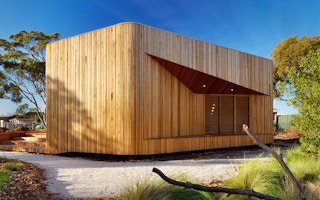The 100 per cent sustainable and renewable Meditation and Indigenous Cultural Centre (M&ICC) at Bentleigh Secondary College has opened its doors to students and teachers.
Designed by dwp suters, the project is a key part of the school’s desire to not only create a sustainable campus, but also change the behaviours of students, staff and the wider community in best practice environmental management.
The M&ICC building acts as a piece of furniture – something to be sat in, on and around – while students engage with the natural Moorooboon wetland surrounds, and a curriculum focused on the environment, indigenous culture and mindfulness meditation.
The design concept reflects the contrasting nature of our inner and outer selves through materiality and form, and materials were chosen to reflect these concepts and key to the success of the design.
Creating a smooth, fluid meditative space, the plywood interior lining stands in striking contrast to the exterior’s angular forms and textured silvertop ash cladding. The cladding skin is expected to age and silver over time, while the interior remains protected and renewed through the practice of reflection and mindfulness.
The centre also incorporates passive heating and cooling design, carbon sequestration design, a wind turbine to provide power and a future geothermal exchange unit for heating and cooling.
Dwp suters Education Sector Leader, Shane Wood, says the project is a good example of how a common goal – an interactive educational environment – can transform a facility from simply being a place to teach and learn to a structure which plays an active role in the learning process.
“The seamless integration of space, materials, technology, and physical form with the environment facilitates an interactive student experience where ultimately the facility becomes the educator,” he says.
Collaboration between all parties played a big part in the design and construction processes to ensure that the common goal of a sustainable design and site that also delivers environmental education was achieved.
“The opportunity for everyone to participate in the construction of the project ensured client, builder and architect worked closely to improve the design and efficiency of the final outcome,” says project architect Nick Cini.
“Dwp suters are passionate about the use of sustainable technology and design within school communities.This technology provides tools for educators to create unique learning opportunities that better equip today’s students to become the sustainable citizens of tomorrow.”








